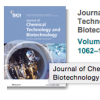
Autores:
J. Arreola-Vargas
F. Alatriste-Mondragón
L.B. Celis
E. Razo-Flores
A. López-López
H.O. Méndez-Acosta
Revista y/o libro:
Journal of Chemical Technology & Biotechnology
Volumen:
90(6), 1062-1069
Año:
2015
Sinopsis:
Previous studies have reported that complexity of the substrate, type of inoculum and reactor configuration strongly affect fermentative hydrogen production. Therefore, the aim of this study was to evaluate the effect of simple (glucose, xylose and sucrose) and complex (acid and enzymatic oat straw hydrolysates) substrates on the continuous hydrogen production in a trickling bed reactor. Novel inoculum (triticale silage) and biofilm support configuration (vertically organized PET tubing) were tested. The enzymatic hydrolysate was a suitable substrate for hydrogen production, since its hydrogen molar yield was similar to that obtained with glucose, mean values of 1.6 and 1.7 mol H2 mol−1 sugar consumed were obtained, respectively. In contrast, hydrogen was not produced from the acid hydrolysate. The highest hydrogen production rate (840 mL H2 L−1 h−1) was obtained with glucose at an organic loading rate of 160 g COD L−1 d−1. In spite of the high organic loading rate applied, clogging due to excessive biomass growth was not observed. Finally, PCR-DGGE analysis revealed that bacteria from Clostridium genus were the putative responsible for hydrogen production.